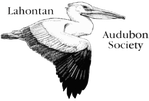FREQUENTLY ASKED QUESTIONS (FAQ)
Bird Health
I'VE FOUND AN INJURED BIRD. WHAT SHOULD I DO?
Lahontan Audubon does not have a permit to care for injured an orphaned wildlife. If you find a bird or other wildlife that requires care, please contact your local wildlife rehabilitator for information on safe handling and transport. Dayton Valley Wildlife Reststop has two rehabilitation centers in Nevada, one in Dayton and one in Sliver Springs. Contact information for our area can be found on our Contact Us page.
Wildlife rehabilitation resources are very limited in Northern Nevada. If you would like to help contribute to wildlife rehabilitation efforts, read about what it takes to be a bird or wildlife rehabilitator in Nevada.
Wildlife rehabilitation resources are very limited in Northern Nevada. If you would like to help contribute to wildlife rehabilitation efforts, read about what it takes to be a bird or wildlife rehabilitator in Nevada.
I FOUND AN ORPHANED OR BABY BIRD, WHAT SHOULD I DO WITH IT?
If you find a baby bird on the ground, it’s best to leave it alone. Baby birds will often fledge (leave the nest) prior to their ability to fly. This is common and an important part of their development. Their parents will still take care of them even if they are on the ground. If the bird is in immediate danger, you can move it to a safer place in the general area. If you are unsure of what to do, read our more in depth article, I Found a Baby Bird, What Should I Do?
BIRDS ARE BUILDING A NEST INSIDE MY GARAGE. I CAN'T USE MY GARAGE WITHOUT DISTURBING THE BIRDS. WHAT SHOULD I DO?
Birds sometimes build nests in "inconvenient" locations for homeowners, such as inside garages, rain gutters or in trees slated to be felled. We at Lahontan Audubon Society do not remove or transport live birds. The Migratory Bird Treaty Act protects most birds and their nests from being removed or destroyed without prior authorization from the US Fish and Wildlife Service (USFWS). If a bird and/or its nest are causing nuisances in and around your home, we definitely recommend contacting the Nevada Department of Wildlife Reno office at (775) 688-1501 for advice about the Migratory Bird Treaty Act and what you should do next.
Click here for more information about bird nests and the Migratory Bird Treaty Act.
Click here for more information about bird nests and the Migratory Bird Treaty Act.
WHAT CAN I DO TO PREVENT BIRDS FROM FLYING INTO WINDOWS?
|
|
Birds and Windows
ABA’s Collisions Program addresses the collision threat to birds through multiple strategies, including research to identify effective collision deterrents, education of architectural professionals through courses that qualify for continuing education credit, development and broad distribution of information resources, helping manufacturers create bird-friendly products, and actively promoting bird-friendly legislation. |

